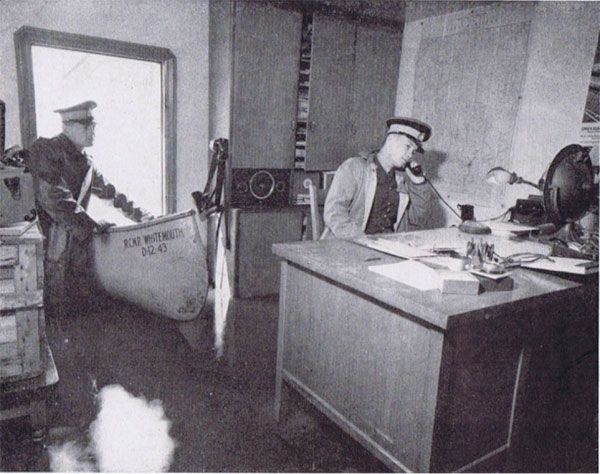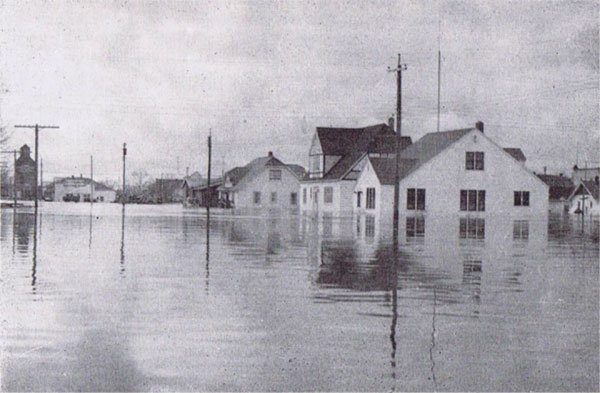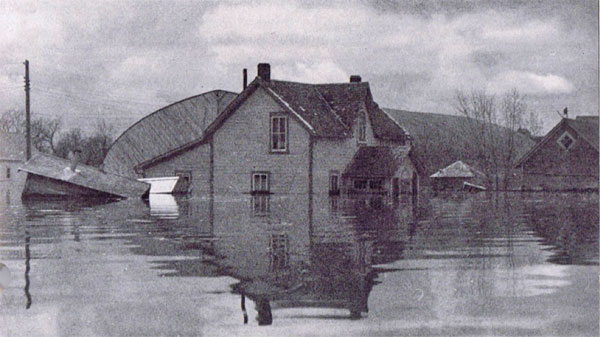
Events
The Rampaging Red
By Inspr. K. M. Lockwood
The RCMP Quarterly October 1950 P. 146-149
A brief account of last spring’s disastrous floods in Manitoba – a calamity that shocked the nation and excited the sympathy of the whole world.
 RCMP Detachment office, Morris, Man. Toward the end of March it became evident from reports submitted by American engineers that the Red River was about to unleash its fury throughout the length of the valley. Levels were rising rapidly south of the border and the volume of water on its way north indicated far more severe flooding than had been experienced in recent years. By early April the deluge had made itself felt at Emerson, the first Canadian town north of the border. From then on it steadily spread over the whole Red River Valley until an area of approximately 600 square miles was inundated. The water varied from one to ten feet in depth and engulfed everything in its path. At one point on the river proper the crew of an RCMP patrol schooner had occasion to drop anchor and before it struck bottom, they had released approximately 90 feet of chain. The towns of Emerson, Letellier, St.Jean, Morris, Rosenort, Rosenfeld, Silver Plains, McTavish, Aubigny, St. Agathe, St. Adolphe, St. Norbert – and all surrounding farm country within approximately 15 miles of the river proper – were almost completely inundated by the “rampaging Red.” Long before the flood reached disastrous proportions certain precautionary measures were taken by the Force. Special radio installations – over and above the regular equipment – insured communications should telephones fail. Arrangements were made for water transport; freighter canoes and other types of suitable boats equipped with outboard motors were shipped into the area. Extra personnel were supplied and before any other organization had taken precautions, the Force was reasonably well prepared for the coming emergency. The ground work was carefully thought out and it was then merely a question of expanding the organization to meet the need as the water rose. On approximately April 12 it became evident the flood was going to assume disaster proportions and on April 17 extra men were sent into the southern area and the writer took up headquarters in Morris to direct the coming battle. On the morning of April 30, at approximately 4 a.m., a wall of water four feet high attacked the town of Morris and in a matter of three hours the whole town was flooded to a depth of about five feet. The water rose steadily during the coming days until it reached a depth of 25 feet on the east side of the town and tapered to roughly five feet on the west side. The area became known as “Lake Morris.” As far as the eye could see in any direction there was an unbroken expanse of water. Highways, railroads, bridges, fences, automobiles and in many cases houses and other buildings were completely covered by the rushing tide.  View of flooded street ij Morris, Man. RCMP building to the right of picture. In the towns throughout the valley – previously listed –the situation soon became impossible. Food, water and other necessities of life were simply nonexistent. This meant only one thing – the mass evacuation of thousands of people, and this was carried out in approximately five days. The small boats equipped with outboard motors and four larger launches which had been loaned to the Force by their owners, were the only means of transportation available. The boats and operators carried on at top speed day and most of the night taking people to safety or to points from which they could obtain transportation. This operation was executed in the most impossible weather and under the most dangerous conditions, yet not a single life was lost or was there an untoward incident of any kind. The morale of the people was excellent and the efficiency, energy and devotion to duty of the members of the Force involved cannot be praised too highly. Many of the men were young and inexperienced yet they performed like veterans and worked almost to the point of exhaustion. The currents of the river were extremely dangerous for the operation of small boats and all through the evacuation there was constant rain or snow with below freezing temperatures – and winds which reached a velocity of 40 miles an hour. The devastation in the Red River Valley is beyond description. Houses, barns and out buildings have simply vanished. Morris itself absorbed the unrelenting fury of the elements for ten days and emerged a battered and splintered town. Huge logs driven by a 40-mile-an hour wind and borne on four foot waves, unmercifully battered the inundated settlement. They smashed their way completely through some houses and reduced others to piles of bricks and splinters which later floated away and left nothing but gaping basements to welcome returning evacuees. In Winnipeg and surrounding suburbs an outstanding job was done by all ranks. Extra men were brought in from Saskatchewan and from Brandon and Dauphin Sub-Divisions and these were welded into a compact efficient force to augment municipal police forces in the emergency. Through the untiring efforts of the executive members of Headquarters, a steady flow of necessary supplies was maintained to the men in the field without which they could not have operated. The radio communications set up before the flood actually struck were a godsend. Telephone communication was practically nonexistent and at its best was unreliable, although the Manitoba Telephone System did a marvelous job of trying to maintain its lines. The police radio network was about the only means of communication from Winnipeg south. To the radio technicians, dispatchers and others connected with this operation goes unlimited credit for the manner in which they enabled this channel to function at its high peak of efficiency. The stenographers and office staff contributed materially to the success of the communications. They worked long hours compiling, sorting and tabulating messages and instructions which were flowing in a constant stream to and from Headquarters. During this emergency extra detachments were set up throughout the Red River Valley at Dominion City, St. Norbert, St. Agathe, St. Adolphe, St. Jean and Letellier. The two members at each of these detachments were equipped with boats, motors, clothing, food, gasoline and other necessary supplies. Three large patrol boats were put into operation – the Atik patrolling from Winnipeg to St. Jean, the Aeronaut from St. Jean to Emerson and the Arcesu covering the whole valley from Winnipeg to Emerson. The crews of these boats used freighter canoes powered by outboard motors to visit all farms and houses within reach of the river. In this way the welfare of the persons still occupying these dwellings was looked after; also the need for cattle feed was noted and such information passed onto the Department of Agriculture. Where houses were still occupied even though partially under water, their locations were listed as well as the names of the owners. A record was kept of each visit to these places. Evacuated homes and buildings were dated in chalk each time a patrol called, for the information of returning evacuees. In these ways the situation was kept under control, looting was prevented and the people were assured that their welfare was being looked after by the patrols of this Force. Arrangements were made with the Manitoba Government Air Service for two aircraft to fly over the entire flooded valley, spot isolated cattle and drop feed to them. This operation was successful and most certainly saved the lives of cattle which would otherwise have starved. The RCMP Beaver Aircraft CF-MPM, stationed at “D” Division, proved useful too. This aircraft made many flights to Morris and district and being equipped with wheels used a portion of No. 75 Highway which had not been flooded, as a landing strip. This runway was approximately 1 ½ miles long and while it is obvious that a highway is not the most desirable landing strip, the skill of our pilot in safely negotiating this improvised airfield time and time again was well demonstrated. Truly the 1950 Red River flood left its unforgettable memories throughout the valley, but likewise the members of the Force lived up to tradition and distinguished themselves in a manner which will long be remembered by the residents of the stricken area.  Wrecked homes in Morris, Man. - an example of what existed in many centres of that province. |